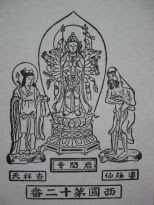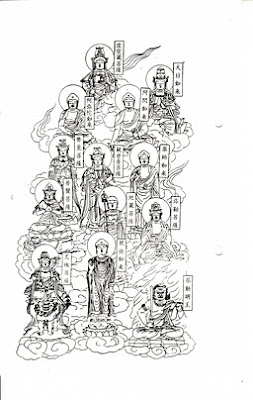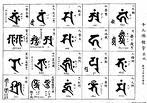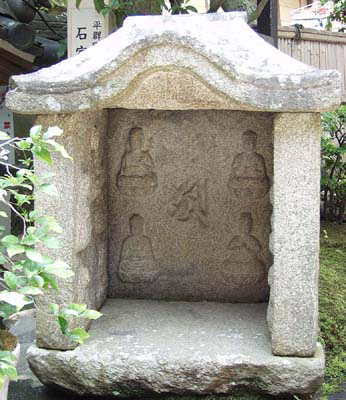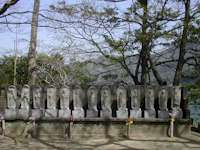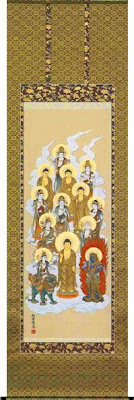- Tsunami Jizo, Namikiri Jizo, see below -
:::::::::::::::::::::::::::::::::::::::::::::::::::::::::::::::::::::::::::::::::::::::::::::::::::::
Wave-calming Fudo, Namikiri Fudo, Namikiri Fudô
波切不動尊 、浪切不動明王 / 波切り不動
http://www.daihou.com/fudou.html
There are more than 2000 Japanese entries googeling with this.
Namikiri Fudo at the Southern Temple at Mt. Koya
Koya-san no Nan-In
波切不動(高野山南院) 南院(なんいん)
This is the Headquarters of all the Namikiri temples 総本家.
http://www.nbn.ne.jp/~mibuko/kouyasan/namikiri.htm
While in China, Kobo Daishi (Kukai, Kooboo Daishii, Kuukai) made a statue of Fudo Myo-o. (Other versions know that he was given the statue by his teacher.)
When he was on his way back from his study trip to China in 806, his ship got caught in a severe storm. He prayed to the statue of this Fudo Myo-O to pacify the waves and behold, Fudo Myo-O thrust out his sword dowart the waves, cut them and the sea calmed.
This is the origin of the Wave-calming Fudo, Wave-cutting Fudo (wellenzerschneidender Fudo), which later became the protector deity of many seafarers and fishermen.
This statue corresponds to the 19 precepts of a classical Fudo statue, but the hair is bundled to small "Treasure knots" (gyokukei ぎょくけい 玉形), as you can see in the replica. It stands on a special throne of wild waves.
不動明王は密教の象徴的存在でもあり胎蔵界曼荼羅・持明院に般若菩薩を中尊として降三世明王・勝三世明王・大威徳明王と共にあり、東寺に於ける羯磨曼荼羅では明王部(五大明王)の中尊である。本来の利益は降魔(悪魔を屈服)にあるが旅・交通安全の守護神になっているのは空海が唐から留学の帰路嵐に巻き込まれた時に波切不動に助けられた伝説によるものと言えよう。
Long List of Fudo Statues and Temples.
http://www10.ocn.ne.jp/~mk123456/fudoo.htm
Replica of the original statue
http://www.daihorin-kaku.com/bijutsu/namikiri-fudo.htm
弘法大師が唐からの帰国途中、嵐に遭い、船が難破しかかったとき、師の恵果和尚から授かった霊木に大師自ら一刀三礼されて刻まれた「不動明王」に祈念申し上げると、その不動尊は、大火炎を発し、右手に持つ「利剣」で波を切り裂いて船を安全に導いたといわれています。・・・・その伝説の浪切不動明王をおまつりしているのが、この南院です。
全国に浪(波)切不動明王は多くまつられていますが、元祖はここ南院です。私はこの南院さんでの特別護摩祈祷を2~3回参拝させていただきました。
http://ha2.seikyou.ne.jp/home/myamo/junsei/essay/meisatu5.html
.. .. .. Replica sold online
〈弘法大師入唐1200年〉を記念し、この霊像を忠実に復刻し頒布することとなりました。
http://www.daihorin-kaku.com/bijutsu/namikiri-fudo.htm

Namikiri Fudo at Nan-In 南院
source : www.sea.sannet.ne.jp
. Fudo Myo-O at Mt. Koya 高野山 Koya San .
.......................................................................
- Chant of the temple
ありがたや生死苦海の浪風を切りはらいたまふ智慧の御剣

shuin 朱印 temple stamp
- Homepage of the temple
- source : www.kinki36fudo.org/36
. Koya San in Wakayama 高野山 和歌山県 .
:::::::::::::::::::::::::::::::::::::::::::::::::::::::::::::::::::::::::::::::
Temple Ooyama-ji, Shikoku Pilgrimage, Off List Nr. 1
Because the characters in the name can be read in two ways, this temple seems to be known by both names, Taisanji and Ôyamaji. Located near the peak of Taisan (or Ôyama) Mountain, it is just west of Temple 4 and between Temples 5 and 6
Legend states that the honzon was given to Kûkai by Huikuo, his master when he was studying in China. Sometime after his return to Japan, it is said that Kûkai gave the statue to this temple. There is also an important statue of Fudô Myôô in the hondô and a statue of Namikiri Fudô (Wave Calming Fudô) in a shrine at the peak of the mountain.
More information of the Off-list temples from the Shikoku Pilgrimage
http://users.lac.uic.edu/~dturk/shikoku/bangaiinfo.html
Mark Schumacher about the Shikoku Pilgrimage and others.
:::::::::::::::::::::::::::::::::::::::::::::::::::::::::::::::::::::::::::::::
Namikiri Fudo-In at the Temple Chooshoo-Ji, Chiba
成東山 不動院 長勝寺
This Fudo Temple was dedicated by Emperor Shomu in the Nara period, after Gyoki Bosatsu (Gyooki) walked in all parts of Eastern Japan in reverence of Fudo Myo-o.
During the Heian Period Kobo Daishi brought his religion to the area of Eastern Japan too and had fire ceremonies (goma kuyoo) for the people.
This Fudo is especially venerated by the fishermen of the area in Kujuku Hama, Chiba.
当山のご本堂には「不動明王」と「こんがら」「せいたか」の二童子が安置され、古来浪切不動と呼ばれています。ご本尊は奈良時代、聖武天皇の八年に行基菩薩が東国巡錫のおり、当地で不動明王の尊像を刻み、寺を建立してお祀りしたのが始まりです。後に平安時代の初め、弘法大師が関東教化のおり、民衆救護のため当山で大護摩を催して民福増進の秘法を行いました。爾来千二百年余りに渡って、法燈連綿として九十九里唯一の霊場として今日に至っています。
特に元禄年中、付近で漁船遭難の際、船頭以下不動明王の尊号を一心に唱和したところ、忽ち雲中に光明が現れ風浪にわかに静まり、一同無事に救われたことは、浪切不動のご利益として今日まで伝えられています。
現在の本堂は、元和四年の大改修以来、江戸・明治・昭和の大改築を経て現在の堂塔となっています。
Talisman for Road Safety
http://www.evam.com/fudoin/index.html
:::::::::::::::::::::::::::::::::::::::::::::::::::::::::::::::::::::::::::::::::
Miyamima, Hiroshima Pref. and Toyotomi Hideyoshi
宮島と豊臣秀吉の不動信仰
At the base of Mt. Misen is Chokugando (Imperial Prayer Hall) of Daisho-in Temple, in which is enshrined the statue of Namikiri Fudo Myo-o, which Hideyoshi had taken on board ship and to whom he offered prayers for safety and success in war when he dispatched troops to invade Korea.
. Daisho-In 大聖院 Miyajima .
:::::::::::::::::::::::::::::::::::::::::::::::::::::::::::::::::::::::::::::::::
Osaka Namikiri Fudo-Son, Nishinari ward
大阪の波きり不動尊
Also known as Mizu-kake Fudo Myo-o, this deity was unearthed at Matsu 1-chome in 1939. It stands approximately 150 cm tall, and was placed next to Saihoji in the same year as its discovery. Its surroundings were destroyed by fire in the numerous air raids during WWII; however, Namikiri Fudoson itself escaped damage. The deity thus gained a reputation as being able to grant wishes, and the number of worshippers grew daily.
http://www.city.osaka.jp/nishinari/english/attract/attrac21.html
.............................................................................................
Daisho-Ji, Namikiri Fudo Hall Chiba
大聖寺 浪切不動堂
. Daishooji 大聖寺 Daisho-Ji . - Chiba
:::::::::::::::::::::::::::::::::::::::::::::::::::::::::::::::::::::::::::
Kabuki
ICHIKAWA EBIZÔ II
(Ebizoo, Ebizo, Ichikawa Danjûrô II - Ichikawa Kuzô I)
November 1755: Ebizô plays in the same theater the roles of Hasebe Chôbei and the deity Namikiri Fudô Myôô in the kaomise drama "Arigatashi Yunzei Genji".
The Ichikawa Danjûrô (Danjuuroo) line of actors is closely related to the cult of Fudô Myôô.
http://www.kabuki21.com/ebizo2.php
. Ichikawa Ebizō V .
- as the Mystical Image (Reizō) of Fudō Myōō,
:::::::::::::::::::::::::::::::::::::::::::::::::::::::::::::::::::::::::::
Statues
Wakayama Pref. Iwasaki
和歌山県西牟婁郡上富田町
丘の上に大きな岩屋があり、その中に堂が作られ、不動三尊が安置されています。不動三尊像は、実に見事な作であって当時のこの地の文化・経済生活を語る資料としても貴重です。
http://www.town.kamitonda.lg.jp/kami50x/13/13.html
.................................................................
Yokohama Namikiri Fudo-Son
Temple Tatsuei-Ji
横浜立江寺 御本尊 横浜波切不動尊
http://www1.ocn.ne.jp/~tatsueji/ofudousama/ofudousama.html
Zushi Fudo 浪子不動
http://homepage3.nifty.com/mgs2/miura/miura-7kusa-koyozi.htm
今から600年以上も昔のことです。披露山の続きの嶺のあたりから夜ごとに不思議な 光が射すようになりました。 すると今までたくさん獲れていた魚がぴたりと獲れなくなってしまいました。近くの漁師 たちの嘆きを聞いた頼基法印という高僧が、光の射す嶺のあたりを調べてみると、岩屋 の中に石の不動尊像を見つけました。
祠を造って丁重に祀ったところ、再び魚が獲れるようになりました。
この祠が、浪切不動とか白滝不動とか呼ばれて、人々の信仰を集めました。
この不動堂の周辺が、徳富蘆花の小説「不如帰」の舞台になったことから、小説 のヒロイン「浪子」の名が転じて浪子不動と呼ばれるようになりました。
http://www.k-skr.or.jp/iijchiku/zushi/zusi.html
:::::::::::::::::::::::::::::::::::::::::::::::::::::::::::::::::::::::::::
Paintings

- source : www.k3.dion.ne.jp/~kanzoin
Fudo Myo-o (Namikiri-Fudo ritsuzo)
Somekawa Eisuke Somekawa 染川英輔 1983
:::::::::::::::::::::::::::::::::::::::::::::::::::::::::::::::::::::::::::::::::::::::::::::::::::::
日本語の資料から:
浪切不動明王は弘法大師空海様が海上安全を祈らんがために自ら一刀三礼彫刻をなされ、尊師恵果阿闍梨の開眼加持を受けた霊尊です。
大同2年(806年)10月大師様御帰朝の際、玄界灘の荒れ狂う風と波に船は翻弄され、たびたび沈没の危機にさらされたとき、大師様が祈念され不動明王を示現されました。火焔を放ち利剣を振って魔風を鎮め、荒波を切り開いて、船を無事博多湾に導かれたのです。このことからこの霊尊を「浪切不動明王」とお呼びするようになりました。
お大師様の一代御本尊として、国家鎮護のため五十数たびの大祈願会をはじめ、日々お大師様自らの御供養をお受けになられました。その後高野全山の祈願本尊として様々な霊威霊験を発しておられます。
特に大きなご縁は、国内を二分して戦った平将門の乱に名古屋熱田の地に出張して降伏護摩を修し、反乱を平定して剣を“熱田神宮”に留め東北を鎮護されました。
弘安四年(1281年)元冦の役の国難には、賢隆阿闍梨以下六十名の僧侶が明王を率いて福岡志賀の島に籠もり、敵前に温座護摩を修し火界の呪を唱えて元軍覆滅を祈り、大神風と相まって国土の鎮護を全うせられました。火焔を西海の“志賀の島”に留めて異国来襲の護りとされています。
建武の中興・明治維新及び世界大戦争等の国難の度に大威力をお示しになり衆生に与えられた数々の御霊験は挙げるいとまがない程です。
高野山南院の御本尊として奉安され、福寿増長、家内安全,五穀豊穣、息災延命など衆生済度に請願をされており、全国にある浪切不動尊の総本家といえるでしょう。
又、福岡はお大師様にゆかりが深く、浪切不動明王のご縁も多くあります。
祈りと行のある処に衆生済度、抜苦与楽の広大なご利益を授けてくださいます。
先祖を想い、親に感謝、人に感謝、そして神仏に感謝。報恩の誠を尽くすことは、授けられた命の輝きになるでしょう。(高野山南院の経典を参考にいたしました。)
Copyright (C) 2004 HOUTOKUJI
http://www.daihou.com/fudou.html
:::::::::::::::::::::::::::::::::::::::::::::::::::::::::::::::::::::::::::::::::::::::::::::::::::::
仏説倶利伽羅大龍王無動陀羅尼経
Sutra with Furigana
不動明王の変化身で龍王の一種。
http://ww7.enjoy.ne.jp/~kjr.t.56.mac/E4.htm
:::::::::::::::::::::::::::::::::::::::::::::::::::::::::::::::::::::::::::::::::::::::::::::::::::::
Namikiri Fudo Talisman at the Temple Nr. 36, Shikoku
青龍寺の波きり不動
. 武相不動尊二十八所 - Busoo - Buso Kanto Pilgrimage
Musashino and Sagami - 28 temples .
13 明王山 西光寺(鴨居山 林光寺) 波切不動尊 - Namikiri Fudo
8 瑞應山 蓮華院 弘明寺 波切不動尊 - Namikiri Fudo
. 東北三十六不動尊霊場
36 Fudo Temples in Tohoku .
09 多聞院 - 波切不動尊 - Namikiri Fudo - Akita
10 吉祥院 - 波切不動尊 - Namikiri Fudo - Akita
- - - 津軽弘法大師霊場 - Tsugaru Kobo Daishi Reijo
Pilgrimage to 23 Kobo Daishi temples in Tsugaru .
. 03 - Hookoo-In 法光院 Hoko-In .
.07 - Kakuooin 覚應院 / 覚応院 Kakuo-In .
.......................................................................
- - - Kyushu 36 Fudo Pilgrims
. Fukushoojin 福昌寺 Fukusho-Ji .
Kagoshima Fudo Pilgrims Nr. 17
. Shookakuji 正覚寺 Shokaku-Ji .
Nagasaki Fudo Pilgrims Nr. 23
:::::::::::::::::::::::::::::::::::::::::::::::::::::::::::::::::::::::::::::::::::::::::::::::::::::
Nakiri Jinja 波切神社 Nakiri Shrine
1 Daiocho Nakiri, Shima, Mie / 志摩市大王町波切1番地
This shrine is located in the 志摩郡 Shima district in the village of 大王町 Daio.
In its compound there is a special stone.
kujira ishi 鯨石 "Whale Stone"
which is said to have been found in the stomach of a whale.

source : wikipedia
The main deity of the shrine is
国狭槌神 (くにのさづちのかみ)Kuni no Sazuchi no Kami
Kunisatsuchi no Mikoto 国狭槌尊
- - - - - The Legend of Nakiri Shrine - - - - -
波切のわらじ曵き
- quote -
Long, long ago, there lived a one-eyed giant, called Hitotsume (一つ目) - With One Eye. He was very fearsome, and did lots of evil deeds, and was always a big problem for the villagers around. He used to churn up the ocean, with his legs, making huge waves, that would run down the lands, and wash off all the crops; he would come into the land and kidnap the village girls.
Fed up with the giant and all his evil deeds, the villagers seek advice from a wise monk called Dandara; who advised the villagers to make a huge straw sandal and float it out into the sea. The villagers followed the advice. Hitotsume found a huge straw sandal floating towards him, and thought that there was much bigger giant than him, living in the village.
Scared, Hitotsume stopped all his evil doings.
Even to this day, the tradition of floating the sandal is performed every September.
- reference source : -
waraji matsuri わらじ祭 straw sandal festival
. More legends from Nakiri .
:::::::::::::::::::::::::::::::::::::::::::::::::::::::::::::::::::::::::::::::::::::::::::::::::::::::::::::::::::::::::::
. 地蔵菩薩 Jizo Bosatsu - Kshitigarbha .
. tsunami 津波 伝説 Tsunami legends .
tsunami Jizoo 津波地蔵 Tsunami Jizo
There are some statues of Jizo with various names, indicating the place where a huge Tsunami stopped after destroying a village.
.......................................................................
namikiri Jizoo 波切り地蔵 "wave-cutting Jizo "
.......................................
Chiba 千葉県

千葉県一宮町東浪見2517 / Ichinomiya, Torami
During the Great Genroku Earthquake in December 1705, 元禄地震 there was a huge Tsunami approaching the Ichinomiya Torami village. This Jizo statue stands on the farthest point where the waves reached, about 1.3 km from the coast. It shows the power of the Genroku Tsunami.
- reference : bousaihaku.com/cgi-bin -
..........................................
In Shizuoka, 下田市 Shimoda town
Once there came shiroi hige no roojin 白いひげの老人 an old man with a white beard.
He warned the residents of Shimoda before a Tsunami and told them to evacuate to the mountain, 下田富士 Shimoda Fuji. After the first Tsunami hit the town, he warned the people again: "There is another big Tsunami coming, so don't go home yet, stay here on the mountain!"
And when the last big Tsunami had hit, there was a sparkle in the sky and he flew off.
This was in fact namikiri Jizo 波切り地蔵.
..........................................
A Jizo statue called 「波切り地蔵」or 矢負い地蔵 Ya hiroi Jizo」
. Kakurinji 鶴林寺 Kakurin-Ji .
Shikoku Henro Temple Nr. 20
.......................................................................
tsunami Jizoo 津波地蔵 Tsunami Jizo
高知県高知市 仁井田 Kochi

source : shikoku-saigai.com/archives
In Memory of the 宝永地震の津波 Hoei Earthquake and Tsunami in 1707.
.......................................................................
michibiki Jizoo みちびき地蔵 Jizo leading the Way
The guiding Jizo
宮城県気仙沼市大島 Miyagi Kesennuma, Oshima
For an earthquake in 1770.

It is featured in the Manga Tales of Japan まんが日本昔ばなし.
- reference : wikipedia -
- After the Great Tohoku Earthquake March 2011
A new Michibiki Jizo was dedicated in Kesennuma,
気仙沼市の後九条 Ushirokujo
made by the actor and sculptor 滝田栄 Takita Sakae in 2013

source : kokoropress.blogspot.jp/2013
.......................................................................
namiseki Jizoo doo 波せき地蔵堂 Namiseki Jizo Hall
京都府宮津市 Kyoto, Miyazu town, near 天橋立 Amanohashidate.

For the Earthquake in May of 701, 大宝元年3月.
- reference : wikipedia -
.......................................................................
namiyoke Jizoo 波除け地蔵 Jizo warding off the wave"
福井県敦賀市 Fukui, Tsuruga

source : pure-pure.air-nifty.com/ai
About 400 years ago, a Tsunami once crossed the pass 関峠 Seki Toge, a pass on the road from Wakasa to Echizen, and came all the way to where this statue is now.
The statue is also called chikara no Jizo 力の地蔵, the Powerful Jizo.
.......................................................................
- reference : 波切り地蔵 -
:::::::::::::::::::::::::::::::::::::::::::::::::::::::::::::::::::::::::::::::::::::::::::::::::::::::::::::::::::::::::::
[ . BACK to DARUMA MUSEUM TOP . ]
[ . BACK to WORLDKIGO . TOP . ]
- #namikiri #namikirifudo #namikirijizo #tsunamijizo -
:::::::::::::::::::::::::::::::::::::::::::::::::::::::::::::::::::::::::::::::::::::::::::::::::::::::::::::::::::::::::::

















